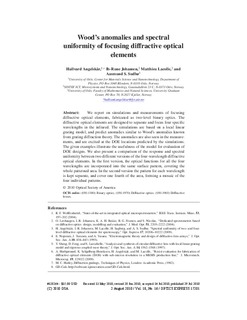| dc.description.abstract | We report on simulations and measurements of focusing diffractive optical elements, fabricated as two-level binary optics. The diffractive optical elements are designed to separate and focus four specific wavelengths in the infrared. The simulations are based on a local linear grating model, and predict anomalies similar to Wood’s anomalies known from grating diffraction theory. The anomalies are also seen in the measurements, and are excited at the DOE locations predicted by the simulations. The given examples illustrate the usefulness of the model for evaluation of DOE designs. We also present a comparison of the response and spectral uniformity between two different versions of the four-wavelength diffractive optical elements. In the first version, the optical functions for all the four wavelengths are incorporated into the same surface pattern, covering the whole patterned area. In the second version the pattern, each wavelength is kept separate, and cover one fourth of the area, forming a mosaic of the four individual patterns. | nb_NO |
